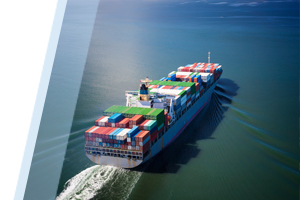
How Mega Ships Impact Ocean Freight Logistics | Transportfolio
We all know that when we go to the store to purchase an item, we often look for a good bargain. After all, when we save a few dollars here and there, it starts to add up. With this in mind, let’s apply the same thinking upstream. Putting production and labor costs overseas aside, transportation becomes the prime target to help drive down costs. As a result, ocean vessels have gotten larger. It’s pretty simple—the more containers you can fit on a vessel, the lower the operational costs are, which can be passed on to consumers for better bargains on the shelf.
In 1957, the average vessel size was only around 750 TEU and they were about 460 feet long. Today, the CMA-CGM Benjamin Franklin that called the USWC not long ago was 18,000 TEU and 1,310 feet long. Some estimates believe vessels will be around 24,000 TEU and 1,410 feet by 2018.
So, bigger is better and will yield better cost savings, right? Not quite. The fact remains that supply chains have many working parts. To get from the factory to a retail shelf you have ports, terminals, rail, trucks, warehouses, and much more to consider. The fact of the matter is bigger ships are affecting ocean freight logistics. Let’s look at how:
Inefficient Unloading and Loading
Inefficient Unloading and Loading | Transportfolio
Often, a voyage consists of several ports. Similar to airlines, ocean vessels needs to maintain its schedule integrity. If the vessel misses a port by even a day, it can cause severe delays and congestions at ports later in the voyage. No one understands this better than those at the port terminals. They will often do just about anything to unload and load the vessel within the given timeframe. To meet a deadline, containers might be inefficiently stacked on top of one another. So it’s no longer first in-first out (FIFO), it’s more like, “first in and we’ll get it out when we can.”
Lack of Terminal Space
Lack of Terminal Space | Transportfolio
Another valid concern about larger vessels is that a ship carrying 18,000 to 19,000 TEUs will need about 100 acres of terminal within the port to carry out efficient operations. With the exception of a few ports, that amount of working space is unavailable at most U.S. ports. Even when nearby land is available, it can take many years to get the necessary permits to construct new terminals and subsequent infrastructure. By the time an expansion may be completed, it may be operationally obsolete because of even larger ships.
Carrier Alliance Confusion
Carrier Alliance Confusion | Transportfolio
There are also carrier alliances to think about. For example, the G6 alliance has six different cargo interests on one vessel, all of which might have different terminal and intermodal interests. When it comes to intermodal moves, the rail lines will need to deal with the additional volumes; to complicate matters even more, they must work with six different shipping lines. This means for the CMA-CGM Benjamin Franklin, rail lines and terminals deal with the equivalent of six 3,000-TEU ships. Carrier alliances further complicate train loading priorities given their various interests. Making matters worse, alliance members are operating multiple terminal interests within a port, which means containers are discharging from a single ship and the chassis may be returned to different terminals. This exacerbates congestion, delays, and financial burden.
Final Thoughts
How Mega Ships Impact Ocean Freight Logistics | Transportfolio
Larger ocean vessels are here to stay. Unfortunately, the infrastructure downstream is not evolving as quickly as it should to handle the increased volumes.
In this complex environment, it’s imperative you ask the right questions to your service provider because a rate upstream will not necessarily mean your overall landed cost will be reduced.
The expanded Panama Canal opened to traffic in June 2016. How will the expansion impact logistics going forward? Read the white paper, Wide Open: How the Panama Canal Expansion is Redrawing the Logistics Map.



